Japanese Design Archive Survey
DESIGN ARCHIVE
Designers & Creators
Sori Yanagi
Industrial designer
Report: 20 July 2016, 13:00 - 14:30
Interview: 24 January 2017, 10:30 - 12:00
PROFILE
Profile
Sori Yanagi
Industrial designer
1915 Born in Tokyo
1940 Graduated from Tokyo Fine Arts School (now Tokyo University of the Arts)
1950 Establishment of the Yanagi Industrial Design Institute
1953 Establishment of the YANAGI DESIGN INSTITUTE
2011 He passed away
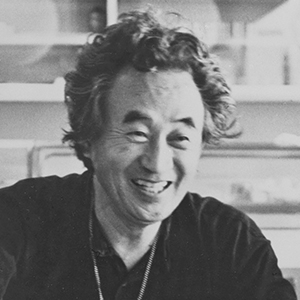
Description
Description
He began his design career in 1946, a year after the end of the war. In the midst of the rapid expansion of consumer culture, he bitterly criticised designers who were complicit in the economic system of mass production and mass consumption. He was dedicated to the question of "what is design?" and pursued design for daily life, not design for sale, but design that is close to people's hearts.
For 65 years, until his passing in 2011, he designed a wide range of products for a wide variety of sectors. He designed tableware and kitchenware such as kettles, cutlery and teapots; industrial products such as record players, sewing machines and cars; sound barriers for motorways, the mouth of the Kan-Etsu Tunnel, footbridges, fire hydrants, Olympic torchbearers, kiosk, scales for shops, oil paint containers, furniture, lighting, textiles, stationery, toys and magazine covers. The "Butterfly Stool", a masterpiece made from two pieces of moulded plywood, is in the permanent collection of the Museum of Modern Art, New York (MoMA) and the Musée du Louvre.
At the same time, he celebrated "design without a designer". The first is the objects that have a beauty that is in accordance with their use, such as jeans, baseballs and pickel, which do not bear the name of their maker, and the second are the tools of daily life produced by the handiwork of nameless Japanese folk in the folk art movement championed by his father, Muneyoshi Yanagi. He believed that this was the origin of life and the source of beauty, and he himself aimed to create objects that were created from the depths of the body, with the ideal of an anonymous design that could be used widely without such names being brought to the fore.
In addition to his design activities, Yanagi was the director of the Japan Folk Crafts Museum in Komaba, Tokyo, from 1977 to 2006, and was dedicated to passing on the ideas of Muneyoshi and the legacy of his predecessors to the present day. The Yanagi-Shop, which sells Yanagi products, is located in Yotsuya, Tokyo.
Masterpiece
Masterpiece
Products
"Elephant Stool" (1954), "Butterfly Stool" (1956), "White porcelain teapot" (1956), "Glass flower vases" (1979), " Black Handle Cutlery" (1982), " Punching Strainer" (1999), etc.
Public facilities
Pedestrian bridge in Kuzuha New Town, Osaka (1972); Yokohama Subway: Drinking fountain and water service equipment on platform (1973); Tomei Expressway: Soundproof panel fences at Tokyo tollgate (1980), etc.
Others
Information board map for Nogeyama Park, Yokohama (1970); Sapporo Winter Olympics: Flame-holder (1972); Nagoya City Subway kiosks (1973); Cover design for monthly magazine "The Mingei" (1977); etc.
Books
"Yanagi Sori dezain" KAWADE SHOBO SHINSHA (1998); "Yanagi Sori Essei" HEIBONSHA (2011)
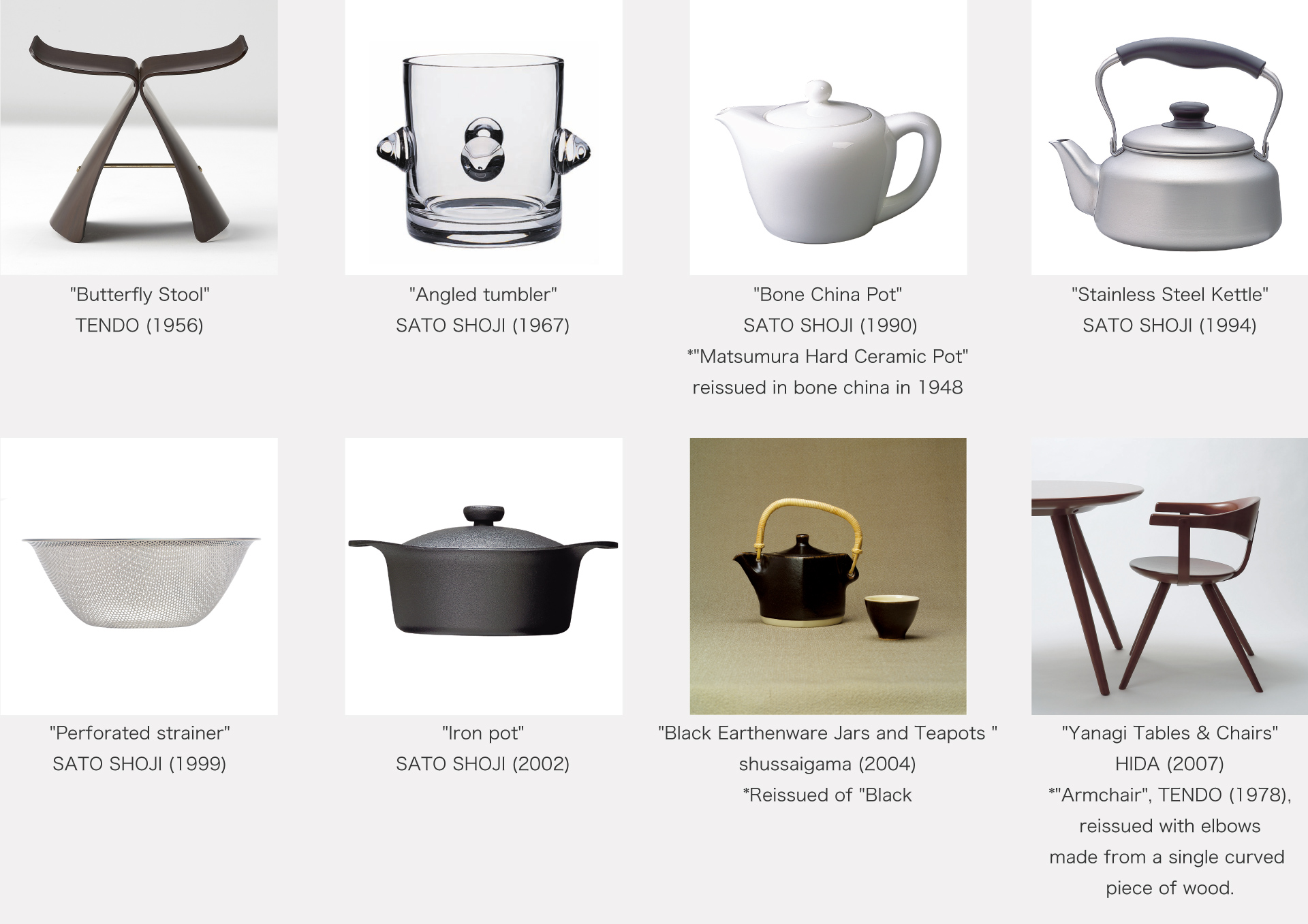
Interview
Interview
Yanagi Sori Design Memorial
Interview: 24 January 2017, 10:30 - 12:00
Location: Yanagi Sori Design Memorial
Interviewees: Hitoshi Mori, Yuriko Minami
Interviewers: Yasuko Seki, Akiko Wakui
Author: Akiko Wakui
Description
The Yanagi Sori Design Memorial is an affiliate of Kanazawa College of Art, which opened in 2014. It is located in an area where a number of cultural facilities are concentrated, including the Izumi Kyoka Kinenkan Museum, the Kanazawa Phonograph Museum and the Kanazawa Literary Hall, and reuses the first and second floors of a building that was once the main shop of the long-established Japanese sweets shop Morihachi. The Yanagi Sori Design Memorial has two exhibition spaces for permanent and temporary exhibitions, as well as a storage room for several hundred works owned by Kanazawa College of Art, a research library and a lecture room for public lectures. In the permanent exhibition room, approximately 200 works by Yanagi are arranged in spaces that simulate everyday life, such as dining rooms and kitchens, and are open to the public, but these works are not captioned or described in any way. The reason for this is that the main focus is on giving visitors a sense of Yanagi's design through direct contact and dialogue with the objects, without giving them any preconceptions. The relationship between Sori Yanagi and Kanazawa College of Art began in 1956, when Yanagi was appointed as a commissioned professor at the college. In the 50 years since then, Yanagi has taught at the university, he has had a profound influence on many students. The Yanagi Sori Design Memorial was established to commemorate these achievements. In 2012, the YANAGI DESIGN INSTITUTE, Sori Yanagi's design office, deposited approximately 7,000 design-related materials for the establishment of the Yanagi Sori Design Memorial. This was an opportunity for academic cooperation between the two parties to organise and research Yanagi's archives. In this second part of our research into the Yanagi Sori archive, we spoke to the two research institutes about their respective roles and how the archive can be used in school education.
In order to showcase design in a comprehensive manner, it is necessary to national museums need to spend time and money to collect things
History of the establishment of the Yanagi Sori Design Memorial and contents of the exhibition
― I understand that the design archive of Mr. Sori Yanagi is managed by the Yanagi Sori Design Memorial and the YANAGI DESIGN INSTITUTE, which have two pillars. First of all, could you tell us how it all started?
Mori Mr. Sori Yanagi taught at Kanazawa College of Art for about 50 years. Because of this connection, we have received requests from retired teachers to build a memorial museum, but we have been unable to do so. In the meantime, approximately 7,000 items of Yanagi Sori's design-related materials owned by the YANAGI DESIGN INSTITUTE in Yotsuya were deposited at Kanazawa College of Art, and it was decided to make use of the building acquired by Kanazawa City.
The original plan was to turn the building into a museum, but unfortunately, due to the building's age and problems with earthquake resistance, it could not be used as a facility that could be visited by an indefinite number of people, so it was decided to operate it in the form of an institute of the Kanazawa College of Art. Therefore, we open the exhibition to the public in the form of artworks that are placed in university classrooms for people to see.
― What kind of works are on display here?
Mori There are two exhibition rooms on the first floor. Exhibition room 1 is a permanent exhibition room where visitors can learn about Sori Yanagi's approach to design through his works and spaces. All of the works currently on display have been deposited, and the YANAGI DESIGN INSTITUTE is responsible for the selection, assembly and layout of the works. Exhibition and reference room 2 is a space used for special exhibitions and events, where we organise one special exhibition a year and several exhibitions a year to show the results of our students' education to the general public. During the rest of the year, video programmes and panels are displayed to inform the public about the relationship between Mr. Yanagi and Kanazawa College of Art.
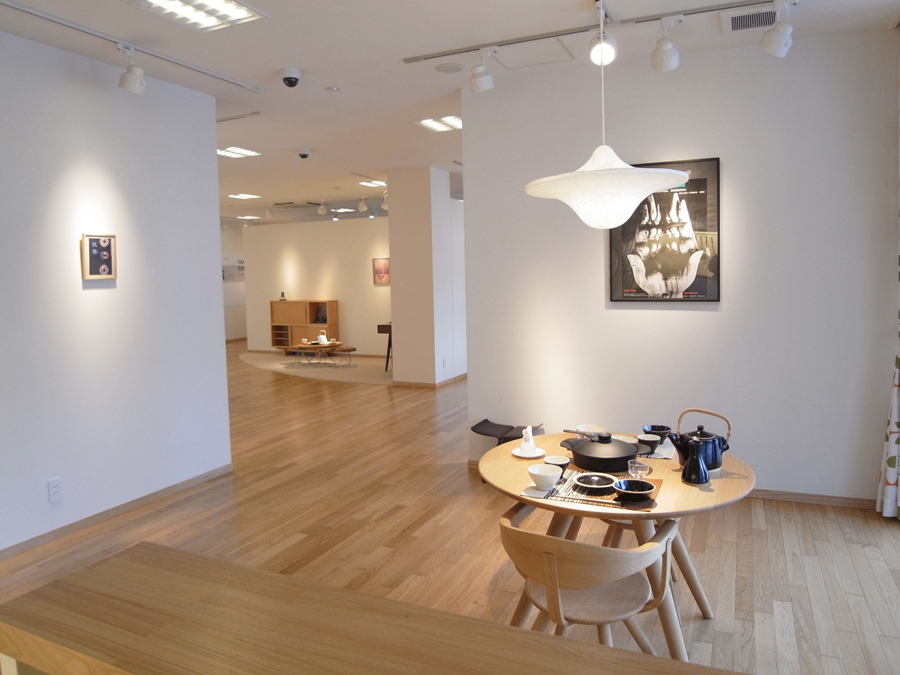
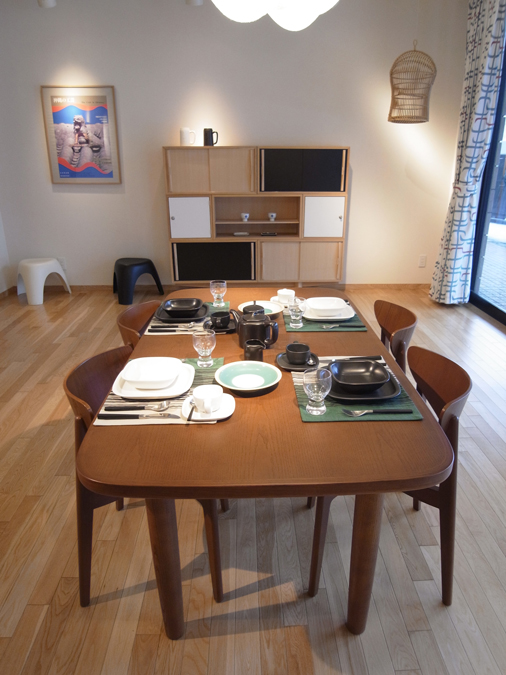
Exhibition Resource Room 1, where Yanagi's work is permanently displayed in a space designed for daily life. No explanatory notes are attached so that visitors can face the designs without preconceptions.
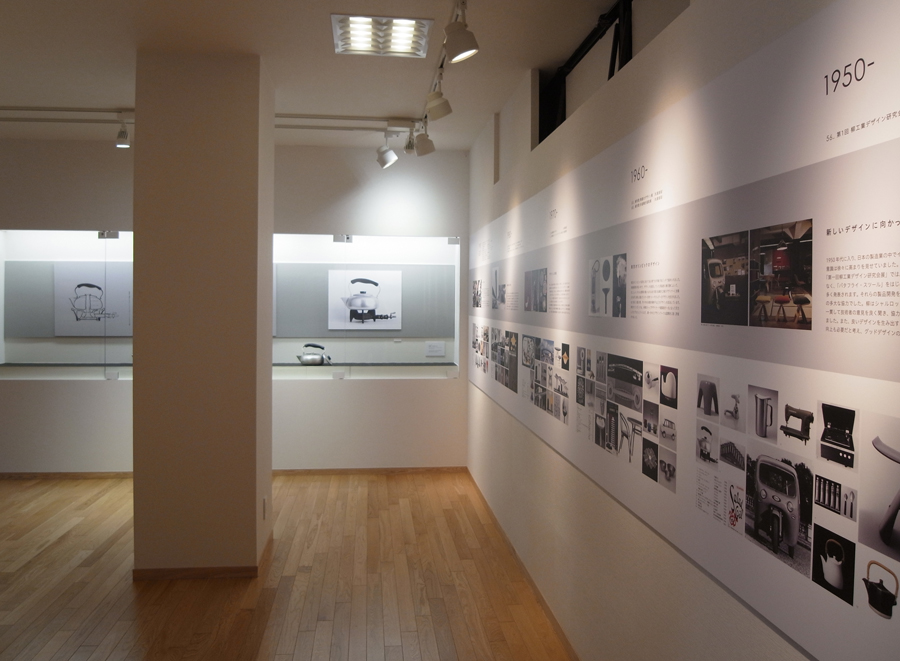
Brief chronology of Mr. Yanagi at the back of Exhibition and Reference Room 1.
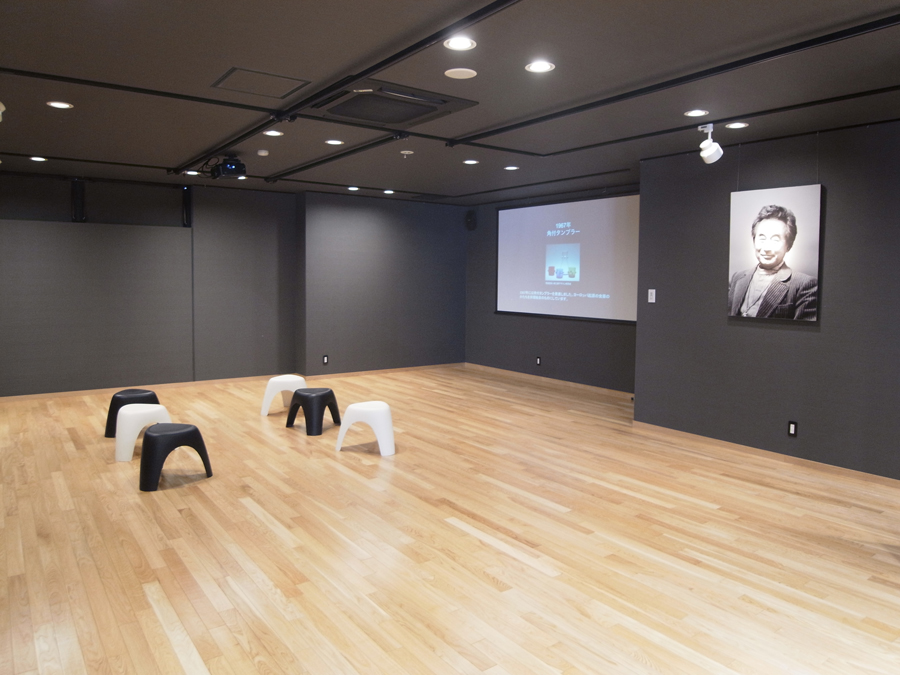
Exhibition and documentation room where special exhibitions are held 2.
― So the permanent exhibition of Mr. Yanagi's work is mainly products rather than a historical archive? What exactly are the deposited materials?
Mori Basically, they are products, and some are prototypes. There were only a few drawings and other materials, so I think they are still at the YANAGI DESIGN INSTITUTE. Apart from that, there are several hundred works owned by Kanazawa College of Art.
Minami Design-related materials that have been deposited are stored in a private warehouse with air-conditioning. The works owned by Kanazawa College of Art are managed in a storage room on the second floor. The vaults are not always open to the public, but can be shown to those who have made an appointment.

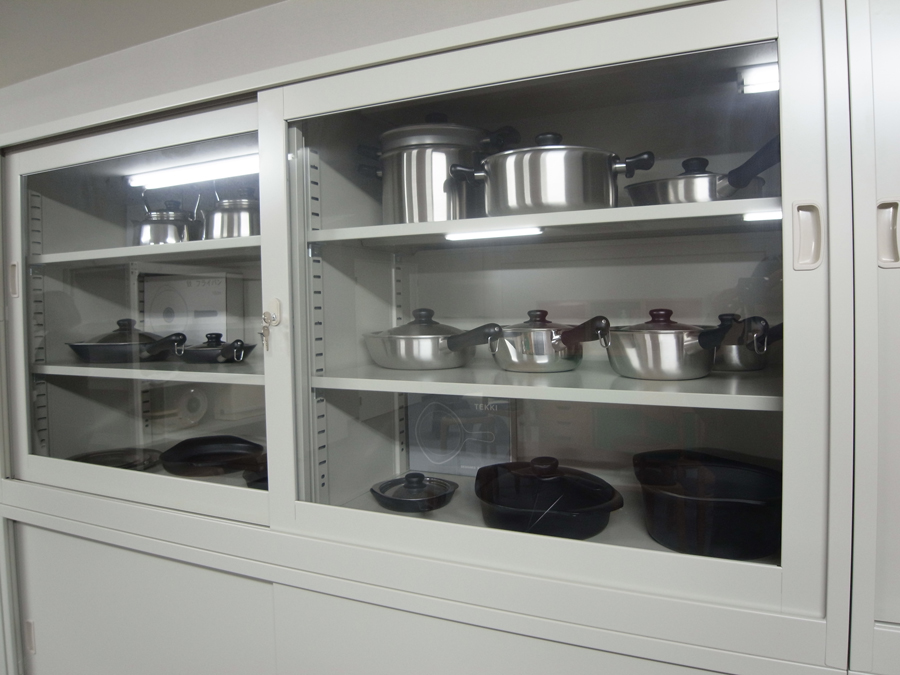
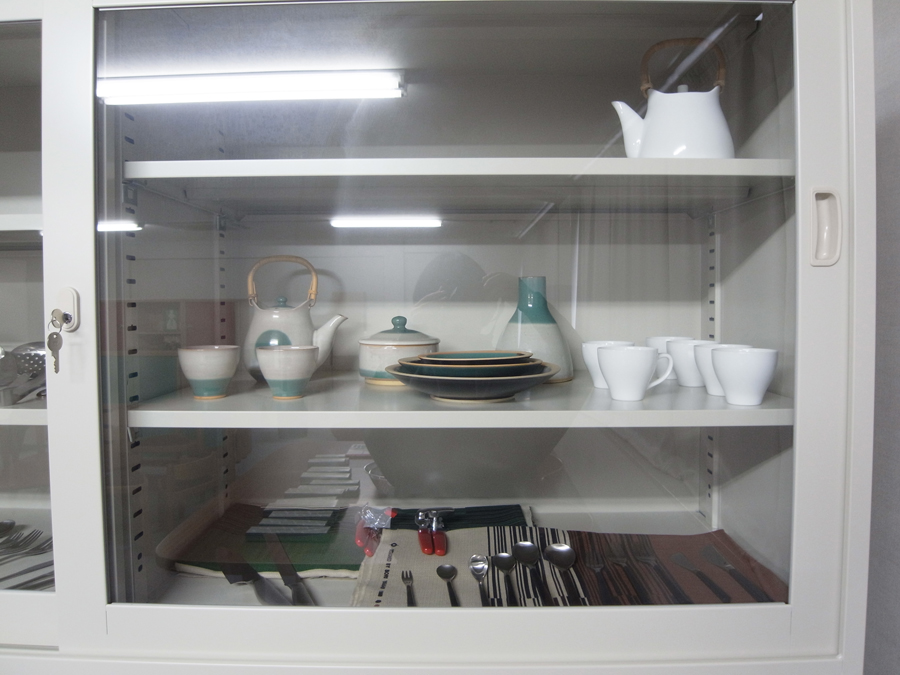
The vaults on the second floor house artworks owned by Kanazawa College of Art.
― How many visitors do you receive here each year?
Mori About 20,000 people. As this is located in the middle of the famous sightseeing spots Ohmicho Ichiba and Higashiyama, many tourists passing by stop by. On the other hand, many foreign tourists seem to go out of their way to see the works of Yanagi Sori.
How the archive can be used for school education
― Are you involved in any initiatives in collaboration with universities, such as classes using Mr. Yanagi's archive?
Mori At the next exhibition, "1955, Industrial Art, Launching - Design Education at Kanazawa College of Art", which will be held from March to May, I would like to do a collaboration with guidance for new students in the design department. 1955 was the year that Kanazawa College of Art was the year that the College of Arts and Crafts became a junior college and then a four-year university, the newly established Department of Industrial Arts invited the leading designers of the time, Mr. Sori Yanagi and Mr. Hiroshi Ohchi, as lecturers. In this beginning year as an art college, we are planning an exhibition to introduce how art education in Japan has tackled design.
As an institution affiliated with a university, our basic premise is to collaborate with school education, so we would like to continue such initiatives in the future.
― It is very important to have a place where the archive can be used in a living form. What kind of presence does Mr. Yanagi have among the current Kanazawa College of Art students?
Mori For today's students, he is no longer a familiar presence. When Mr. Yanagi was a commissioned professor, he used to give two or three-day intensive lectures several times a year. There are no recordings of his lectures, but from the notes he left behind, it seems that he talked a lot about the mindset of a designer, rather than practical design methods. I think this was a great stimulus for those who were going into industrial design. However, from a certain age, the time spent in contact with students became less and less, so there must be a big difference in such density.
Minami We have alumni visiting our institute as well, and the stories of the generation who received lectures directly from Mr. Yanagi are still passionate, and we get a glimpse of how influential he was. However, when it comes to today's students and graduates from a certain age, there seems to be a difference in the way they perceive Mr. Yanagi and the density of his lectures. So I hope that we can bridge the gap between generations through school education. In that sense, things like oral history are also important.
Mori I have heard that the YANAGI DESIGN INSTITUTE is interviewing graduates in generational order.
Revision of chronology and catalogue through steady research
― I understand that a lot of research is required to organise an exhibition by Mr. Yanagi, but is this at the same time linked to your research activities?
Mori Yes, it is. The deposition agreement with the YANAGI DESIGN INSTITUTE, which I mentioned earlier, is about academic cooperation using the deposited materials as the core. One of the things we are working on is the revision of the chronological records. For example, until now it was assumed that Mr. Yanagi's graduation year from the Tokyo Fine Arts School was 1939, but we found out that it was actually 1940. In the past, technical schools had a five-year system, but after the war, with the new university system, the system was changed to a four-year system, so I think he himself was mistaken.
He also went to the Philippines during the war, and although there are records that he returned to Japan in 1946, the year after the war ended, most books do not say what month it was. It was only recently, when we were preparing for the exhibition, that we discovered that it was in May.
― Did you go to the Philippines as a soldier?
Mori At the time, he was a researcher at the Junzo Sakakura architects and engineers (now Sakakura Associates), and I think he went there to assist in the construction of assembly houses and other structures designed by Mr. Sakakura for use by the Japanese in the area. The reason why the month of return is important is that it affects the length of time between the first white ceramic series and 1947. If he returned to Japan in May 1946, he had about a year to present his work. This was a very big gain. I have also been working on a catalogue of his works, supplementing the data with reexamination of his published writings.
This kind of research to correct basic data has been ongoing since the institute was founded, and we share this information with the YANAGI DESIGN INSTITUTE.
― That is also a valuable archive. Mr. Sori Yanagi is probably one of the most studied designers.
Mori I think the YANAGI DESIGN INSTITUTE has been a continuous source of information. However, since they also supervise Mr. Yanagi's design and develop products, it must be difficult to conduct research that unravels the literature one by one. So I think we should take on that kind of thing as our role.
The need for a national design museum
― How do you think the design legacy of Mr. Yanagi and other masters should be archived?
Mori I still think it is impossible without a national design museum. There are more objects than works of art, so it would take a huge volume to store them. I don't think that is a task that can be done by one local authority.
― Yesterday, I visited the Research Institute, for Architectural Archives, Kanazawa Institute of Technology, which has a huge amount of material, and they seem to be having a lot of trouble securing space and managing it.
Mori The National Archives of Modern Architecture, Agency for Cultural Affairs is only three or four years old, but it is already full. I think the problem of space is a big one. Another is manpower. Data processing is often done digitally, so it doesn't take up much space, but before that you need to read the data. Moreover, the paper used for old drawings has deteriorated, so drawings in poor condition cannot be opened many times. Then when they are unfolded the first time, all kinds of things have to be done at the same time, such as loading work and care. In other words, there are different things that can and cannot be done, depending on whether or not a lot of human resources can be invested.
― Musashino Art University is running a project to promote archiving, but is it possible for designers' universities and colleges to take the initiative in creating their own archives in the future?
Mori Universities also have limited premises, so there is a limit to the amount of storage space they can have. Therefore, I think it would be difficult to collect the works of all the designers associated with the university.
― Mr. Yanagi's products are household items that do not become obsolete over time, but on the other hand, industrial design, which is constantly being updated through the evolution of technology, has an even greater number of products, doesn't it?
Mori Essentially, I think manufacturers should archive their products properly. Some manufacturers, such as Panasonic and Sony, are doing this, but overall they are not investing enough. Toyota Motor Corporation also has a large museum as a Japanese manufacturer, but Ford Motor Company, which is not even close to Toyota in terms of sales, has a much larger museum.
As a curator, I have been involved in exhibitions of various products, but it has been difficult to collect things from manufacturers, so I have had to compensate by buying things from the collector's market. The current situation is that it is difficult to rely on manufacturers, so in order to present design in a comprehensive way, I think it is necessary for national museums to spend time and money to collect objects.
― Thank you very much for your valuable opinions. As for the archive of Mr. Yanagi, it seems that it will be further enriched in the future through mutual cooperation between the two research institutions. Please let us know if you make any further progress.
Enquiry:
Yanagi Sori Design Memorial https://www.kanazawa-bidai.ac.jp/yanagi/
Report
Report
YANAGI DESIGN INSTITUTE
Interview: 20 July 2016, 13:00 - 14:30
Location: YANAGI DESIGN INSTITUTE
Interviewees: YANAGI DESIGN INSTITUTE
Interviewers: Yasuko Seki, Aia Urakawa
Author: Aia Urakawa
I want my products and materials to be used by different people, not stored away, and I want them to be kept in one place as much as possible
He started his design work as a foundation
Mr. Yanagi began his design career in 1946, at the age of 31. Four years later, in 1950, he opened the Yanagi Industrial Design Institute. With the aim of educating and promoting design, the institute became a foundation in 1953 and was renamed the YANAGI DESIGN INSTITUTE. After Mr. Yanagi's passing, the foundation was transformed into a general incorporated foundation in 2013. Today, the YANAGI DESIGN INSTITUTE supervises and develops new products based on Mr. Yanagi's designs, and organises and researches the design archive. We spoke to the researchers about the group's vision of Sori Yanagi's design archive.
Yanagi's vision of the ideal
Mr. Yanagi never talked about the specifics of what to do with his own design archive. He did say, however, that he did not want to keep his products and materials locked away, but that he wanted them to be used by many people, and that he wanted to keep them in one place as much as possible.
Before his passing, he also wanted to build a museum of modern crafts near the Japan Folk Crafts Museum. He wanted to house not only his own products, but also the finest modern domestic and foreign household utensils. The Japan Folk Crafts Museum was established by Mr. Muneyoshi Yanagi's father in 1936 in Komaba, Meguro-ku, Tokyo, as "a place to show the standards of craftsmanship, to help create new lifestyle crafts". Mr. Muneyoshi is known as the founder of the Mingei movement in the Taisho era, together with ceramicists Mr. Kanjiro Kawai and Mr. Shoji Hamada. The Mingei movement was a movement to raise awareness of the importance of handcrafted culture in various parts of Japan in the face of industrialisation and the spread of mass-produced goods in our daily lives, and to explore the meaning of true abundance.
Mr. Muneyoshi saw the beauty in the tools of daily life made by the people, and travelled around Japan collecting them throughout his life. The Japan Folk Crafts Museum contains around 17,000 pieces of ceramics, lacquerware, textiles, paintings and other objects from Japan and abroad, dating from the Jomon period to the early Showa period.
As a young man, he found Mr. Muneyoshi's collections old-fashioned and became obsessed with avant-garde art, before discovering the Bauhaus and Mr. Le Corbusier as a student and turning to machine-made design. It was Ms. Charlotte Perriand, a collaborator of Mr. Le Corbusier, who changed his mind about the folk art. When Ms. Perriand was invited to Japan in 1940 as a craft instructor, he took on the role of supporting her tour of Japan and her exhibitions. It was during this visit to Japan that she became very interested in the Japan Folk Crafts Museum, and it was there that he also discovered the beauty of Mingei.
Yanagi wanted to build a modern craft museum near the Japan Folk Crafts Museum, because she thought it was necessary to put together the best of Mingei and mechanical products, to show the connection between them, and to pass on what he had received from them to the future. Unfortunately, that modern craft museum never came to fruition.
Academic cooperation with Kanazawa College of Art
Around 1990, when Mr. Yanagi was in his mid-70s, the members of the YANAGI DESIGN INSTITUTE began voluntarily organising photographic materials, models and prototypes little by little, with the aim of bequeathing the design products they had worked on and other items to the next generation. Organising and researching the design archive began in earnest in 2012, after Mr. Yanagi's passing.
In 2012, due to a connection with Kanazawa College of Art in Kanazawa, Ishikawa Prefecture, where Mr. Yanagi taught for more than 50 years from 1955, an academic cooperation agreement was concluded and approximately 7,000 products and other design-related materials were deposited. In 2014, the "Kanazawa College of Art Yanagi Sori Design Memorial" was established as an affiliated facility of the university.
The facility displays some 200 products, such as the "Elephant Stool", "Monjiro Tea Table" and tableware made in shussaigama, and provides a place where visitors can actually touch and feel Mr. Yanagi's designs in a space designed to simulate daily life. The reason why there are no captions or explanatory text for each product is that the museum wants visitors to "face the objects without any unnecessary knowledge or preconceptions and to feel the beauty honestly through their own eyes".
In addition to researching and studying design in the period in which Mr. Yanagi lived, the institute also holds exhibitions and public lectures to present the results of its research, as well as providing books and information related to Mr. Yanagi. The approximately 7,000 design-related materials deposited are stored not in the institute but in a warehouse in Kanazawa City.
The warehouse contains products such as furniture, tableware and cutlery, graphic designs such as covers for the magazine Mingei and exhibition posters, industrial products, benches and other public furniture, models, prototypes and product drawings. The warehouse's holdings, together with the journals, manuscripts, handwritten notes, letters and newspaper serials stored within the YANAGI DESIGN INSTITUTE, are currently being examined and researched by the researchers.
Spaces that retain the atmosphere of the period
Several researchers are still employed by the YANAGI DESIGN INSTITUTE. The furniture in the space is designed by Mr. Yanagi, as well as chairs by other designers selected by him. Work desks and chairs, including a motorised wheelchair that was used to make models. There is also a simple sink and gas stove. As they often developed kitchen utensils, they took turns cooking with prototype pots and pans at lunchtime, exchanging ideas and opinions while everyone ate together and discussed their ideas.
The wooden shelves are decorated with books, folk art and antiques collected by Mr. Yanagi in Japan and abroad. He considered display to be a form of design, and each time he added a new item to his collection, he put his own twist on the way it was arranged. The shelves and the production site have often been introduced in magazines and books. Today, the researchers are consciously trying to preserve the shelves that Mr. Yanagi displayed and the atmosphere in which he was engaged in his design activities at the time, as much as possible.
Some of the product drawings and photographs are also kept in this foundation. Photographs, both paper prints and films, are kept, some of which have become mouldy or discoloured, but are now managed in dry cabinets. Product photos were taken by an exclusive photographer under the supervision of Mr. Yamagi. He also likes cameras, and there are a number of photographs left behind, especially those taken on his travels.
The current debate within the foundation is whether the space itself, which embodies the idea that new design ideas can be generated by keeping good things close at hand, should be preserved as it is, or whether the items collected by Mr. Yanagi, which can also be called design resources in the face of earthquake and other risks, should also be stored as archives in the warehouse.
What are the problems and challenges
What are the current problems and challenges in organising and researching the Mr. Yanagi’s design archive? For one thing, because the archive was never intended to be preserved, there is a lack of information on the content of the material, and it takes time and effort to find out the facts.
For example, many photographs are not clearly marked by the photographer and the owner of the copyright is unknown. In addition, some Mr. Yanasi’s products have been long-selling for more than 50 years. Some of them have had to undergo slight changes in shape due to changes in materials along the way, changes in the manufacturers contracted to produce them, or manufacturing problems. However, as there is almost no documentation to support these changes, it is said to be difficult to determine whether the stored items remaining today are the final product or a prototype in the process of being examined.
In addition, some of the research involves conducting oral histories with former employees who worked with Mr. Yanagi on manufacturing or were employed by the manufacturer at the time, which requires specialist design knowledge in addition to knowledge as an archivist. Therefore, when conducting such archival research and storage, it would be ideal to have a team of several people with different knowledge and abilities.
Opinion about the Design Museum
In the course of their research into Mr. Yanagi's archive, they have heard various opinions on design museums. Some of them are: "Isn't it uninteresting to simply exhibit design archives"; "Shouldn't we create a museum that exhibits in a way that conveys the design process, including the background and philosophy behind the creation of objects"; "What should we do to properly convey designers' design activities through exhibitions? Isn't it important to discuss that first?" etc.
There are also opinions such as "Is it really a good thing for designers to show all the archives including the design process?" and "Isn't it a blasphemy against designers?". This is on the grounds that it might include things that the designers themselves do not approve of as final products, or that might actually be worthy of being discarded by the designers.
In addition, there is a general opinion that "It is more important to archive the present", and "It would be better to store the current archive as digital data, and then select and discard it again when the copyright expires".
Connecting activities to the future
Design is inextricably and strongly linked to social activities. Mr. Yanagi also worked as a foundation with the idea of promoting design widely, and said before his passing that he wanted various people to make use of the design archive. The foundation also believes that it is important not only to keep Mr. Yanagi's archive as it is, but also to have as many people as possible utilise it, make it useful to society and link it to the future. Creating a museum to display Mr. Yanagi's archive is a goal.
The foundation also hopes to pass on the contents of its ongoing archive research and study activities, as well as Mr. Yanagi's design methods and ideas, to the younger generation and students, and pass them on to the next generation. They are currently at the stage of considering this.
Enquiry:
YANAGI DESIGN INSTITUTE http://yanagi-design.or.jp

